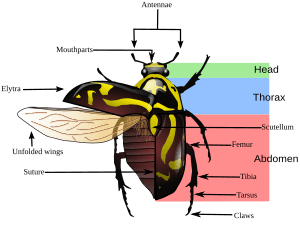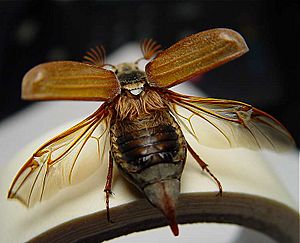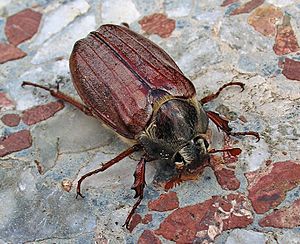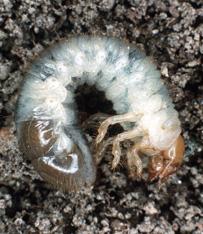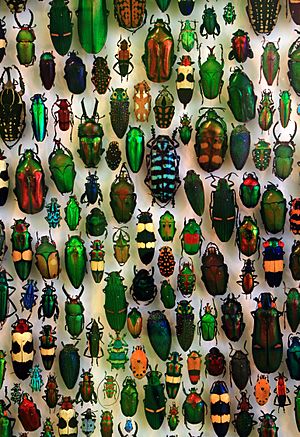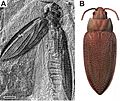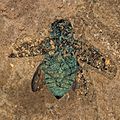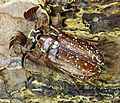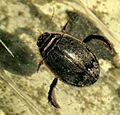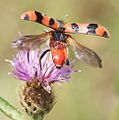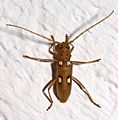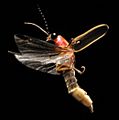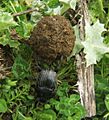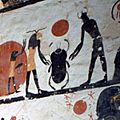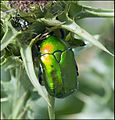Beetle facts for kids
Quick facts for kids Beetles |
|
|---|---|
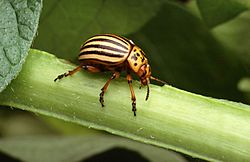 |
|
| Colorado beetle, Leptinotarsa decemlineata | |
| Scientific classification | |
| Kingdom: | |
| Phylum: | |
| Class: | |
| Subclass: | |
| Infraclass: | |
| Superorder: | |
| Order: |
Coleoptera
Linnaeus, 1758
|
| Suborders | |
Beetles, also known as the order Coleoptera, are the biggest group of insects on Earth. There are about 350,000 different species of beetles that scientists have named. This means almost 40% of all known insects are beetles! Scientists think there might be as many as 800,000 to a million living species. Beetles live almost everywhere, except in the ocean or very cold places like Antarctica.
Beetles changed and grew into many different forms very early in their history. The growth of flowering plants helped beetles become even more diverse. Four out of the six largest beetle families mostly eat flowering plants.
Contents
What Makes a Beetle a Beetle?
Like other insects, a beetle's body has three main parts. These are the head, the thorax (the middle part), and the abdomen (the back part). On its head, a beetle has antennae (which are like feelers), eyes, and a mouth. The beetle's legs and wings are attached to its thorax. The abdomen usually doesn't have special parts on the outside. But it holds the beetle’s gut inside.
Beetles don't have internal bones like humans. Instead, they have a hard outer shell called an exoskeleton. This exoskeleton is made of tough plates of a material called chitin.
Beetle Wings
Beetles are special among flying insects. Their front wings have evolved into hard covers called elytra. These elytra protect the delicate back wings. The back wings are thin and are used for flying. When a beetle is resting, its back wings are folded neatly under the elytra. To fly, beetles lift their elytra out of the way. Some true bugs have a similar setup.
Not all beetles can fly. Some beetles don't have back wings at all. Others can't lift their front wings to fly. A few beetles have no wings. Some wingless beetles look like larvae and are called "larviform." For example, female glow-worms (family Phengodidae) stay larviform their whole lives.
Beetle Legs
Beetle legs help them walk, run, swim, and dig. All beetles have six legs. Each leg is made of several parts. The end of each leg has two to five small sections called tarsi. The very last tarsus (which is one tarsus) has one or two claws.
Most beetles use their legs for walking or running. Some water beetles have flat legs with long hairs. These legs help them swim. Beetles that dig in soil often have flat legs with spines or horns. These are called fossorial legs. A few beetles have large back legs, like grasshoppers. These legs help the beetle jump. Flea beetles are an example of jumping beetles.
Sight and Smell

Beetles have compound eyes. This means their two big, shiny eyes are actually made of many smaller parts. Sometimes, each eye is divided in half. This makes it look like the beetle has four eyes! Whirligig beetles have divided eyes. This lets them see above and below the water at the same time when they swim. A few beetles also have extra simple eyes, usually two, called ocelli. These ocelli are on the top of the beetle’s head.
Beetles use their antennae to smell things. They also use their antennae to feel what's around them. Beetle antennae come in many shapes. Some are long and thin, called filiform antennae. Others are short and wide at the end, called clavate antennae.
The Beetle Mouth
A beetle's mouth is very different from a human's mouth. Most beetles have two hard parts at the front of their mouth called mandibles. These are a bit like strong teeth. Mandibles help the beetle eat by crushing and cutting food. In some beetles, the mandibles look like big pincers. Beetles also have four "fingers" around their mouth. These "fingers" are called palpi. They help push food into the beetle's mouth.
Other Body Parts
Beetles don't breathe like we do. Instead, they have small holes called spiracles on the sides of their bodies. These holes lead to tubes called trachea, which work like lungs. Beetles don't have red blood. They have a fluid like blood called haemolymph. It's usually green. This is because their haemoglobin molecule has a copper atom in its center. Our haemoglobin has an iron atom.
How Beetles Grow: The Life Cycle
Beetles start their lives as eggs. A female beetle can lay thousands of eggs during her life. When an egg hatches, a larva comes out. Most beetle larvae do not look like adult beetles. A beetle larva eats and grows. Then it changes into a pupa. When the pupa opens, an adult beetle emerges. This way of growing up is called complete metamorphosis.
Beetles eat the most when they are larvae. Some beetle larvae eat the outside of plants. Others eat inside plants. Some beetle larvae are predators. This means they hunt and eat other insects. Other beetle larvae eat dead things, like dead plants and animals.
Not all beetle larvae look the same. Some are flat and move very fast. Scientists call these campodeiform larvae. Some larvae look like hard worms with tiny legs. These have an elateriform shape. Click beetle larvae have a special name: wireworms. Other beetle larvae are short and very thick. These are called grubs. In a few beetles, the larvae change their shape over time. Blister beetle larvae start fast, like campodeiform larvae. But they end up slow and thick.
What Beetles Do
Food and Diet
Beetles eat many different things. This includes living plants, rotting plants, dead or alive animals, and animal faeces (poop). Some beetles can eat both plants and animals. Others eat only one type of food. Beetles that eat only one kind of thing are called host specific. Many leaf beetles and longhorn beetles are host specific.
Protection from Danger
Beetles are tough for their size. Their hard elytra make them strong. They also have many ways to avoid being attacked by predators or parasitoids. These ways include camouflage, mimicry, being toxic, and actively fighting back.
Some beetles live in places that are hard for predators to find. For example, longhorn beetles live in tunnels inside tree branches. Only special predators that are small enough can get into these tunnels to eat them.
Other beetles don't hide in special places. Instead, their colors or shapes make them hard to see. When beetles have colors that help them blend in, it's called camouflage. Some leaf beetles are green. This helps them hide on green leaves. Some beetles have very complex colors that make them look like bird droppings.
Sometimes beetles use bright colors to warn predators. This is called warning colouration. Some beetles have black and yellow stripes. This makes them look like bees and wasps. Some beetles even behave like bees to confuse predators.
Beetles have many chemical defenses. They often get these chemicals from the plants their larvae eat. These chemicals make them taste bad to predators. Blister beetles are so poisonous that if a horse eats just a few, it could die. Bombardier beetles squirt hot, poisonous liquid at attackers. Lady beetles release a cyanide compound when bothered. Lady beetles also have warning colors. Insects that taste bad use bright colors that birds learn to avoid. Other tasty species sometimes copy these warning colors. This is a type of mimicry and is common in insects.
Very large beetles sometimes fight predators. Beetles that fight often use their strong mandibles to hurt their attackers.
Beetle Reproduction
Beetles have sexual reproduction. Almost all of them go through complete metamorphosis. Some beetles have special behaviors to find a mate. They use pheromones, which are chemical signals. Different species use different pheromones.
Before mating, some male beetles might fight to win a female. This often happens with stag beetles. Males use their long mandibles to fight. More often, male and female beetles go through a long routine before mating. The exact steps are different for each species. This helps make sure that beetles only mate with others of their own kind.
Some beetles take special care of their eggs or larvae. Some scarab beetles, known as dung beetles, roll balls of dung (poop). They put these balls in a hole in the ground. The female lays her eggs in the dung. When the eggs hatch, the larvae eat the dung their mother provided.
How Beetles Evolved
In 2009, a fossil beetle was found in Illinois. This showed that beetles existed as far back as 318 to 299 million years ago. Fossils from this time have been found in Asia and Europe. Other fossils have been found in the Czech Republic and Russia. The first discoveries in North America were published in 2005 and 2008.
After a big extinction event called the Permian–Triassic extinction event, there aren't many insect fossils. But some beetles from the Lower Triassic period have been found. At a site in Russia, many beetle fossils were found. These included whole specimens of early beetle groups like Archostemata, Adephaga, and Polyphaga.
During the Jurassic period (210 to 145 million years ago), the number of beetle families greatly increased. This included the growth of beetles that ate meat and those that ate plants. Dung beetles and plant-eating beetles that lived on conifers (cone-bearing trees) were common in the Jurassic period. The evolution of flowering plants in the Cretaceous period led to the huge number of beetle species we see today.
Types of Beetles
Beetle Suborders
There are four main living groups, or suborders, of beetles:
- Adephaga: This group has 40,000 known species in 10 families. It's the second largest suborder. Members include ground beetles, tiger beetles, predacious diving beetles, and whirligig beetles. Most species in this group are Carabidae, or ground beetles.
- Archostemata: This is the smallest suborder of beetles. It has fewer than 50 known species in five families. Archostemata is a very old group. Its members look similar to the first beetles that appeared in the fossil record about 250 million years ago.
- Myxophaga: This is the second smallest suborder. It has 65 species of tiny beetles in four families. Members of this suborder live in water or near water. They eat algae.
- Polyphaga: This is the largest and most diverse suborder of beetles. Its name means "eaters of many things." Polyphaga has 144 families in 16 superfamilies. They show a huge variety of specializations and adaptations. There are over 300,000 described species. This is about 90% of all beetle species found and named so far. There are five smaller groups within Polyphaga:
- Bostrichiformia — includes furniture beetles and skin beetles.
- Cucujiformia — includes lady beetles, longhorn beetles, weevils, checkered beetles, and leaf beetles.
- Elateriformia — includes click beetles and fireflies.
- Scarabaeiformia — includes scarab beetles and stag beetles.
- Staphyliniformia — includes rove beetles and water scavenger beetles.
Common Beetle Families

Different kinds of beetles are divided into groups called families. There are many beetle families. Here are some of the biggest ones:
- Ground beetles (family Carabidae) are often black. You can find them under rocks. They eat other insects.
- Leaf beetles (family Chrysomelidae) usually eat the outside parts of plants.
- Longhorn beetles (family Cerambycidae) have very long antennae. Most longhorn beetle larvae eat inside plants.
- Weevils (family Curculionidae) have long faces that look a bit like an elephant's trunk. Weevils eat plants.
- Scarab beetles (family Scarabaeidae) have antennae that are wide at the end. Dung beetles are a group within this family. Other scarabs are very colorful and eat plants.
- Rove beetles (family Staphylinidae) have short front wings. These wings do not cover their abdomen. Rove beetles eat other insects.
Popular Names for Beetles
People often use different names for beetles. This can be confusing. That's why biologists use scientific names in Latin. For example, fireflies (also called lightning bugs) are actually beetles. So are ladybirds or ladybugs, which biologists call lady beetles.
Biggest and Smallest Beetles
- Nanosella fungi: This is the smallest beetle, only 0.35 mm long.
- Titanus giganteus: This is the largest beetle, growing 12 to 20 cm long.
Beetles and People
Some beetles cause problems for farmers and people in forests. They eat crops or trees. These beetles are called pests. One beetle that harms crops is the Colorado beetle. Another is the Maize weevil. The Emerald ash borer destroys trees.
Other beetles help people. Lady beetles (also called ladybirds and ladybugs) eat insects that harm crops and trees.
People who study beetles are called coleopterists.
Images for kids
-
Fossil buprestid beetle from the Eocene (50 mya) Messel pit, which retains its structural color
-
Polyphylla fullo has distinctive fan-like antennae, one of several distinct forms for the appendages among beetles.
-
Acilius sulcatus, a diving beetle with hind legs adapted as swimming limbs
-
Scarabaeiform larva of Hercules beetle
-
The ivory-marked beetle, Eburia quadrigeminata, may live up to 40 years inside the hardwoods on which the larva feeds.
-
A camouflaged longhorn beetle, Ecyrus dasycerus
-
Clytus arietis (Cerambycidae), a Batesian mimic of wasps
-
Blister beetles such as Hycleus have brilliant aposematic coloration, warning of their toxicity.
-
An Israeli Copper Flower-Chafer (Protaetia cuprea ignicollis) on a crown daisy (Glebionis coronaria)
-
A scarab in the Valley of the Kings
-
Larvae of the Colorado potato beetle, Leptinotarsa decemlineata, a serious crop pest
-
Coccinella septempunctata, a predatory beetle beneficial to agriculture
-
Mealworms in a bowl for human consumption
-
Zopheridae in jewellery at the Texas A&M University Insect Collection
-
"Remarkable Beetles Found at Simunjon, Borneo". A few of the 2,000 species of beetle collected by Alfred Russel Wallace in Borneo
-
Titan beetle, Titanus giganteus, a tropical longhorn, is one of the largest and heaviest insects in the world.
-
Hercules beetle, Dynastes hercules ecuatorianus, the longest of all beetles
See also
 In Spanish: Escarabajos para niños
In Spanish: Escarabajos para niños


